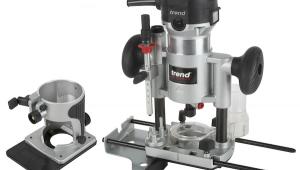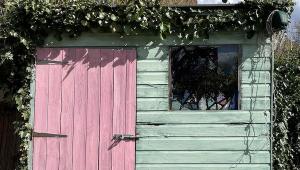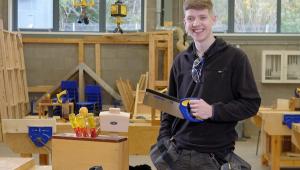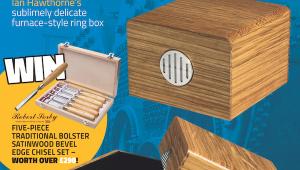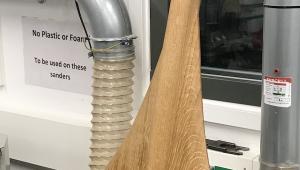Raking up the past
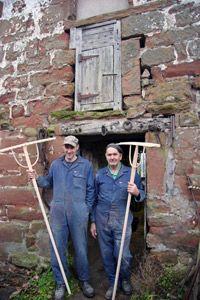
In a small workshop in Dufton, time has stood still for more than a century. Rustic-looking metal tools line the walls, the smell of wood-smoke drifts out of the open fire, and a tattered receipt lying on the table records a purchase paid for in shillings. Thick, dusty stone walls support the low ceiling, and piles of sawdust cover the floor.
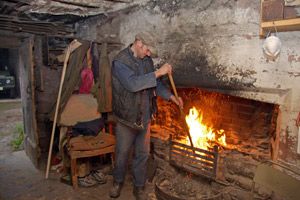
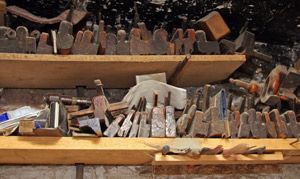
This is the workplace of father and-son-team John and Graeme Rudd, who are part of a tradition of wooden hay rake makers. Working peaceably together all year round, they produce around 10,000 rakes a year. And as far as they are aware, they’re the only ones still making them.
The business was started by John’s grandfather around 1890. When serving an apprenticeship with a village joiner, he developed a liking for rake-making. As the demand gradually lessened, other village joiners stopped producing them, but he continued, passing the tradition down to John’s father and eventually to John himself. “I’m nearly 70 and I started this job when I was a little kid,” John says. “So I’ve probably been doing it for 65 years.”
As he speaks, John is operating the machine that hammers the teeth into the rake heads, while his son Graeme methodically feeds in the teeth.

Loud as the machine is, the rhythm is soothing, and for a few moments the three of us fall silent, hypnotised by the motion. The two men have developed a working method of quiet companionship over the years, with no evidence of the expected father-son tiffs. “Well, it’s because the machines are usually running, so we never really talk!” Graeme jokes.
The workshop used to be a house, and the lettering on the bricks outside reveals that it was built in 1632. “There won’t be many folk working in a workshop that’s nearly 400 years old, will there?” John points out.
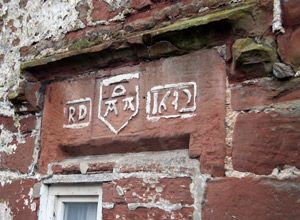
Opposite is a shed, which used to be his grandfather’s house, and is now home to the diverse types of wood used. And diverse they are: the rake heads are made from Yorkshire wood, but the teeth and boughs are constructed from silver birch wood imported from Sweden. The rest of the wood is sourced from Malaya.
Apart from the machine they are using, which was bought in 1949, the workshop has barely been altered in well over a century. “Those work benches were here long before I was,” John says.
And in all this time, the business has continued steadily, even during the Second World War. “We carried on right through the war: in fact we actually had a German prisoner working here,” John recalls. “He did quite a bit, but as soon as the war finished the Russians wanted him back, because he was a craftsman.”
While the prisoner may have left at the end of the war, one thing that remained was the fire engine, mounted on a hand cart, which is still stored in an outside shed. Every village was given one of these during the war, John explains.
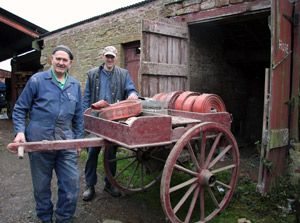
“After the war they wanted to collect them back in, but we wouldn’t part with ours,” he says. “In winter time our roads can get blocked with snow, and we’ve always been able to reach any fire long before the engines come.” The last of these occurrences was about two years ago, he recalls, when they successfully stopped a fire spreading in the village.
The workshop is not the only part of Dufton that has been unaltered by the passage of time. In fact, the village itself has the feeling of being perched comfortably in an earlier period, with its 17th, 18th and 19th century houses surrounded by rolling hills.
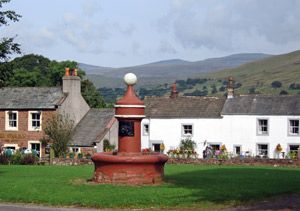
A main feature is the fountain built there by members of the Quaker-owned London Lead Company, who developed the village. Its Latin inscription reads: “There is a clear pool, whose waters gleam like silver. It is not tainted by shepherds, or by their she-goats grazing on the mountain. Nor is it muddied by cattle, or by birds or wild animals, or by a branch fallen from a tree”, which seems to sum up Dufton’s untainted nature.
Nestled in this fitting environment, the Rudds’ work continues steadily. Before tractors became common, the rakes were used almost exclusively for hay timing. Today, this function is less common, but they are still used for purposes such as raking leaves and smoothing the sand in golf club bunkers and long-jump pits. As a result, John explains, demand continues all year round, rather than being seasonal. “It’s steady now, rather than being a mad rush for three months as it once was,” he says.
But what of the future? Is there another Rudd to carry on the family’s work? While Graeme does have a son, neither of the men intends to put any pressure on him.
“I’ll probably keep doing it, but I don’t know about my son,” Graeme says. “He’s six, and when I was six I was already coming in here quite often to help, and he doesn’t seem too interested. It’s up to him. But it’s nice being your own boss; I would certainly encourage him to do that. It has its plus sides.”
This aspect, John agrees, is one of the job’s better perks. “We don’t make a lot of money, but as Graeme says you’ve got your independence and you’re only working for yourself.”
“We’ll certainly carry on making rakes for a good while,” he says. “It’s what we’ve always done.”
- Log in or register to post comments

